|
|
|
Sort Order |
|
|
|
Items / Page
|
|
|
|
|
|
|
| Srl | Item |
| 1 |
ID:
093834


|
|
|
| 2 |
ID:
093824


|
|
|
|
|
| Publication |
2010.
|
| Summary/Abstract |
Drug Trafficking Organizations (DTOs) - commonly called drug cartels - are challenging states and their institutions in increasingly brutal and profound ways. This is seen dramatically in Mexico's drug wars and the expanding reach of Mexican organized criminal enterprises throughout Latin America and other parts of the world. This essay updates a 1998 paper 'Cartel Evolution: Potentials and Consequences' and examines current cartel and gang interactions. The paper links discussion of cartel phases to gang generations; updates and applies the discussion of third phase cartel potentials to Mexico; and assesses four alternative futures for Mexico, as well as their cross-border implications for the United States.
|
|
|
|
|
|
|
|
|
|
|
|
|
|
|
|
| 3 |
ID:
093827
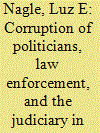

|
|
|
|
|
| Publication |
2010.
|
| Summary/Abstract |
Mexico is a failing state, languishing under a deeply entrenched system of political corruption that undermines the three branches of government and compromises Mexico's law enforcement and national security capabilities. This article explores the culture of corruption that pervades the state and frustrates the rule of law in Mexico, examining how the political elites, the judiciary, and police officials embrace corruption as a primary means for career advancement and for acquiring personal wealth. It is an examination of a country overwhelmed by a system of government and commerce that has grown dependent on corruption in order to function. But such a system cannot sustain itself indefinitely, and the signs of the Mexican state's collapse are becoming more apparent in the wake of unprecedented political and social violence at the hands of corrupt actors and Mexican drug lords.
|
|
|
|
|
|
|
|
|
|
|
|
|
|
|
|
| 4 |
ID:
093833
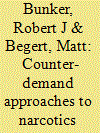

|
|
|
|
|
| Publication |
2010.
|
| Summary/Abstract |
The illegal narcotics demand in the US is discussed in relation to the products supplied by the Mexican cartels. This is then contrasted with major legal commodities with addictive properties consumed in the US. Overlaps of use are also noted. Traditional, right of center, and left of center counter-demand approaches to narcotics trafficking are also surveyed. All of these approaches represent no-win scenarios for the US with its 'troubled population' of addicted users. Final analysis suggests that a blended counter-demand strategy should be explored based on extinguishing demand, coercing the users, and, to some extent, fulfilling user demand by the provision of prescription narcotics to 'special status' addicts and by means of limited decriminalization of personal marijuana use. Such a suggested strategy would have its own negative elements and should be considered less of a bad choice than the other, even worse, US counter-demand policy options that exist.
|
|
|
|
|
|
|
|
|
|
|
|
|
|
|
|
| 5 |
ID:
093831
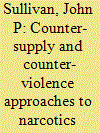

|
|
|
|
|
| Publication |
2010.
|
| Summary/Abstract |
Narcotics and the drug trade contribute to a range of social ills. Among these are social instability, violence, corruption, and a weakening of the state. A range of criminal enterprises, including transnational gangs and drug cartels are engaged in the global trade in illicit drugs. This essay looks at measures to stem this trade through interventions directed against the drug supply and efforts to limit the violence that results from the drug trade. As such it looks at 'counter-supply' and 'counter-violence' approaches. While it emphasizes the impact on the Western Hemisphere - the United States and Latin America - it has international implications for global and national security, intelligence, and law enforcement.
|
|
|
|
|
|
|
|
|
|
|
|
|
|
|
|
| 6 |
ID:
093828
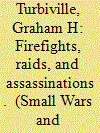

|
|
|
|
|
| Publication |
2010.
|
| Summary/Abstract |
This article examines some specific types of narco-generated combat, assault, and brutality that over the last decade have acquired an increasingly organized and paramilitary character. The planning; training; intelligence and counterintelligence preparation; mobility; communications; type of weaponry; levels of intensity; and sheer audacity substantially exceed the threats with which traditional law enforcement had been trained and equipped to deal. It matches the apt Drug Enforcement Administration description of a 'transition from the gangsterism of traditional narco hit men to paramilitary terrorism with guerrilla tactics'. These methods have become a mainstay in the struggle of narco-traffickers against law enforcement, the military, and to a major degree among the competing drug-trafficking organizations themselves. While the infrastructure and practice of paramilitary violence is established in Mexico in seemingly unprecedented ways, the concern north of the border is its potential transportability. Many law enforcement personnel have compared 1980s Miami - with its running drug firefights, revenge raids, and bloody assassinations by Colombian cocaine traffickers - to Mexican drug violence. There are enough precursors north of the Rio Grande now to make the potential for something analogous more than empty speculation.
|
|
|
|
|
|
|
|
|
|
|
|
|
|
|
|
| 7 |
ID:
093825


|
|
|
|
|
| Publication |
2010.
|
| Summary/Abstract |
Today, analysts of the postmodern era recognize that worldwide conflicts are increasingly influenced by the interaction between terrorists, criminals, gangs, and private armies and that this interaction is a threat to the nation state. Now, a related threat is coming into play - one that involves all of these types of groups being represented at once in a single adversary. One such multifaceted group that is in the forefront is Los Zetas, a band of Mexican cartel enforcers that cannot be easily categorized, assessed, or targeted. Within broad categories of a multitude of irregular groups, Los Zetas embodies such capabilities as extensive compartmentalized networking, pervasive intelligence and counterintelligence capabilities, amassing of advanced weaponry, brutal tactics, top level military and police training, and the ability to undermine state governments and control large swaths of territory. Los Zetas, if left unchecked and unexamined, could potentially become a great security problem for Mexico, the US, and Central America. This essay provides an operational assessment that explores Los Zetas using various criteria traditionally used by nation state militaries, and more recently by Terrorism Early Warning Groups, to assess opposing forces (OPFOR). The purpose of this operational assessment is to provide a baseline understanding of Los Zetas that would make them less imposing and more targetable.
|
|
|
|
|
|
|
|
|
|
|
|
|
|
|
|
| 8 |
ID:
093823
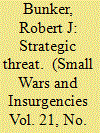

|
|
|
|
|
| Publication |
2010.
|
| Summary/Abstract |
This introductory essay provides a strategic overview of the threat posed by the largest Mexican drug cartels (The Federation, Gulf, Jurez, and Tijuana), and affiliated mercenary groups and street and prison gangs, to the United States. Cartel areas of operation in both Mexico and the United States are highlighted along with linkages to affiliated enforcers and gangs such as Los Zetas, the Mexican Mafia (La Eme), and Mara Salvatrucha (MS-13). The illegal economies of these threat groups - ranging from narcotics trafficking through commodities smuggling and theft, extortion and kidnapping, weapons trafficking, and street taxation - is discussed. The trans-operational environments involving US engagement with the Mexican cartels, mercenaries, and their Sureos affiliates is then characterized. Lastly, individual contributions to this work are summarized.
|
|
|
|
|
|
|
|
|
|
|
|
|
|
|
|
| 9 |
ID:
093826
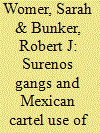

|
|
|
|
|
| Publication |
2010.
|
| Summary/Abstract |
Narco use of the Internet, specifically social networking sites by Surenos gang and Mexican cartel members, is a rich yet underexplored area of research in open venues because of its sensitive nature. This essay provides overviews of Surenos gang and Mexican cartel use of the Internet by means of viewing and analyzing primary Internet sources linked to purported narcotics groups and their associates. These patterns of use were then compared to more sophisticated Internet use by terrorist groups with similarities and contrasts noted. This essay concludes with a few general observations concerning likely narco Internet use patterns that will emerge.
|
|
|
|
|
|
|
|
|
|
|
|
|
|
|
|
| 10 |
ID:
093830


|
|
|
|
|
| Publication |
2010.
|
| Summary/Abstract |
This essay provides an overview of those incidents of torture and beheadings linked to the Mexican cartels and their mercenary and gang affiliates taking place both within Mexico and the United States. Specific forms of torture are discussed as well as the most likely victims and perpetrators. Beheadings, primarily taking place only in Mexico, are also analyzed with supporting database information provided. The occurrences of torture and beheadings tied to these cartels, both in Mexico and more recently across the border into the United States, beg the question of the context in which they are being conducted. Most cases of torture or beheading are regarded as primarily secular in nature - a terrorist tactic tied to economic or political gain. In an even more macabre twist, however, certain instances have been seen as intertwined with a group's belief system, performed in ritual fashion to fulfill religious or spiritual demands. This suggests that the emergent Mexican narcocultos that are evolving may further increase drug war violence to new levels of brutality heretofore unseen.
|
|
|
|
|
|
|
|
|
|
|
|
|
|
|
|
|
|
|
|
|